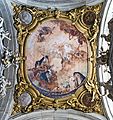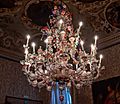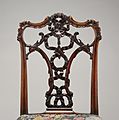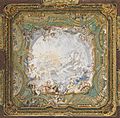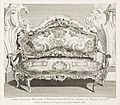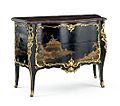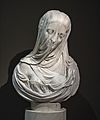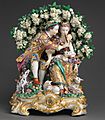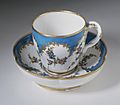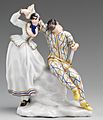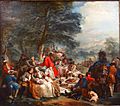Rococo facts for kids

Rococo was a popular art style that started in France in the 1700s. It grew out of the earlier Baroque art movement. While Rococo kept some fancy and detailed parts of Baroque, it was also more fun and less formal.
Rococo is often linked to the time of French King Louis XV. This style was most popular in the middle of the 1700s. By the end of the century, a new style called Neoclassicism became more popular.
Rococo art and buildings often looked soft, pretty, and very decorated. Artists used creamy and light pastel colors in paintings. This was different from the darker colors used in Baroque art. Rococo art didn't always focus on religion or politics. Instead, it often showed everyday life. Themes like love, fun, nature scenes, and simple portraits were common. Art from Far Eastern countries, especially China (called Chinoiserie), also became popular in Rococo. Famous Rococo artists include Boucher, Watteau, and Fragonard.
People have talked a lot about Rococo art over the years. Some critics said it was too much, not serious, or just for fun. Sometimes, the word "Rococo" was even used to mean something silly. But many people also praised Rococo art. They loved its elegance, beauty, and charm.
Contents
What is Rococo Art?
Rococo is an art style that began in the 1700s. It started in France and spread across Europe. It was a lighter, more playful version of the earlier Baroque style. Think of it as Baroque's younger, more cheerful cousin!
Key Features of Rococo
Rococo art and architecture had several special features:
- Soft Colors: Unlike the deep, dramatic colors of Baroque, Rococo used lots of light, creamy, and pastel shades. Imagine soft pinks, blues, and greens.
- Playful and Fancy: Rococo art was very decorative. It had lots of curves, swirls, and fancy details. But it also felt light and fun, not heavy or serious.
- Everyday Life: Rococo artists often painted scenes from daily life. They showed people having fun, falling in love, or enjoying nature. This was a change from the religious or political themes common before.
- Nature and Gardens: Many paintings featured beautiful landscapes, gardens, and outdoor parties.
- Asian Influences: Designs from China, known as Chinoiserie, were very popular. You might see Chinese-inspired patterns or figures in Rococo art and furniture.
Rococo in Different Arts
Rococo wasn't just about paintings. It influenced many types of art:
- Painting: Artists like Watteau and Fragonard painted scenes of romance and fun.
- Architecture: Buildings had curved walls and lots of detailed decorations inside. Rooms felt bright and airy.
- Furniture: Rococo furniture was elegant and comfortable. It often had curved legs and delicate carvings.
- Sculpture: Sculptures were graceful and often showed mythological figures or playful scenes.
Famous Rococo Artists
Several artists became well-known for their Rococo works:
- Antoine Watteau: He painted dreamy scenes of people in beautiful landscapes. His works often showed parties or plays.
- François Boucher: Known for his charming and often playful paintings. He frequently painted mythological scenes and portraits.
- Jean-Honoré Fragonard: His art is full of movement and light. He painted many romantic and fun scenes, like people swinging in gardens.
Images for kids
-
Capital of the Engelszell Abbey, from Austria (1754-1764)
-
Frederick the Great, from Johann H. C. Franke, about 1781
-
Salon of the Hôtel de Soubise in Paris (1735–40) by Germain Boffrand
-
The door of the Hôtel de Marsilly, with two corbels and a cartouche above it, all of them being rococo
-
Eglise Notre-Dame, Bordeaux (1684-1707)
-
Ceiling of church of Santi Giovanni e Paolo in Venice, by Piazzetta (1727)
-
Amalienburg pavilion in Munich by François de Cuvilliés (1734–1739)
-
Hall of Mirrors of Amalienburg by Johann Baptist Zimmermann (1734–1739)
-
Looking up the central stairway at Augustusburg Palace in Brühl by Balthasar Neumann (1741–1744)
-
The Wieskirche by Dominikus Zimmermann (1745–1754)
-
Interior of the Basilica of the Fourteen Holy Helpers by Balthasar Neumann (1743–1772)
-
The Kaisersaal in the Würzburg Residence by Balthasar Neumann (1749–1751)
-
Festival Hall of the Schaezlerpalais in Augsburg by Carl Albert von Lespilliez (1765–1770)
-
Golden Cabinet of the Chinese Palace, Oranienbaum, Russia, built by Antonio Rinaldi for Catherine the Great (1762–1778)
-
Design for a State Bed by Thomas Chippendale (1753–54)
-
Proposed Chinese sofa by Thomas Chippendale (1753–54)
-
Side chair; Thomas Chippendale; circa 1755–1760; mahogany; Metropolitan Museum of Art (New York City)
-
Clock-chest for Frederick the Great (1742)
-
Antoine Watteau, Pilgrimage on the Isle of Cythera (1717)
-
"Luncheon with Ham" by Nicolas Lancret (1735)
-
Ceiling of the Salon of Hercules by François Lemoyne (1735)
-
Ceiling fresco in the Würzburg Residence (1720–1744) by Giovanni Battista Tiepolo
-
Ceiling of the Wieskirche by Johann Baptist Zimmermann (1745–1754)
-
Cupid by Edmé Bouchardon, National Gallery of Art (1744)
-
Atlantides in the upper Belvedere Palace, Vienna, by Johann Lukas von Hildebrandt (1721–22)
-
Assumption scene by Egid Quirin Asam (1722–23) former monastery church, Rohr in Niederbayern
-
El Transparente altar in Toledo Cathedral by Narciso Tomé (1721–32)
-
Portal of the Palace of the Marquis de Dos Aguas, Valencia, Spain (1740-1744)
-
Fountain of Neptune and Amphitrite Palace of Versailles, by Lambert-Sigisbert Adam and Nicolas-Sebastien Adam (1740)
-
The Music Lesson, Chelsea porcelain, Metropolitan Museum (c. 1765)
-
Cup with saucer; circa 1753; soft-paste porcelain with glaze and enamel; Los Angeles County Museum of Art
-
Church of São Francisco de Assis in Ouro Preto, Brazil, 1749–1774, by Aleijadinho
-
St. Andrew's Church in Kyiv, 1744–1767, designed by Francesco Bartolomeo Rastrelli
-
Eszterháza in Fertőd, Hungary, 1720–1766, sometimes called the "Hungarian Versailles"
-
Electoral Palace of Trier
-
Basilica of Santo Domingo in Lima, Peru, completed in 1766, by Manuel d'Amat i de Junyent
-
Antoine Watteau, Pierrot, 1718–1719
-
Antoine Watteau, Pilgrimage to Cythera , 1718–1721
-
Jean François de Troy, A Reading of Molière, 1728
-
Francis Hayman, Dancing Milkmaids, 1735
-
Charles-André van Loo, Halt to the Hunt, 1737
-
Gustaf Lundberg, Portrait of François Boucher, 1741
-
Giovanni Battista Tiepolo, The Banquet of Cleopatra, 1743
-
Maurice Quentin de La Tour, Full-length portrait of the Marquise de Pompadour, 1748–1755
-
François Boucher Portrait of the Marquise de Pompadour, 1756
-
Jean-Honoré Fragonard, The Swing, 1767
-
Jean-Honoré Fragonard, Inspiration, 1769
-
Jean-Honoré Fragonard The Meeting (Part of the Progress of Love series), 1771
-
Élisabeth Vigée-Lebrun, Marie Antoinette à la Rose, 1783
-
Jean-Baptiste-Siméon Chardin, Still Life with Glass Flask and Fruit, c. 1750
-
Jean-Baptiste Greuze, The Spoiled Child, c. 1765
-
Joshua Reynolds, Robert Clive and his family with an Indian maid, 1765
-
Angelica Kauffman, Portrait of David Garrick, c. 1765
-
Louis-Michel van Loo, Portrait of Denis Diderot, 1767
-
Thomas Gainsborough, The Blue Boy, 1770
-
Thomas Gainsborough, Portrait of Mrs Mary Graham, 1777
See also
 In Spanish: Rococó para niños
In Spanish: Rococó para niños














